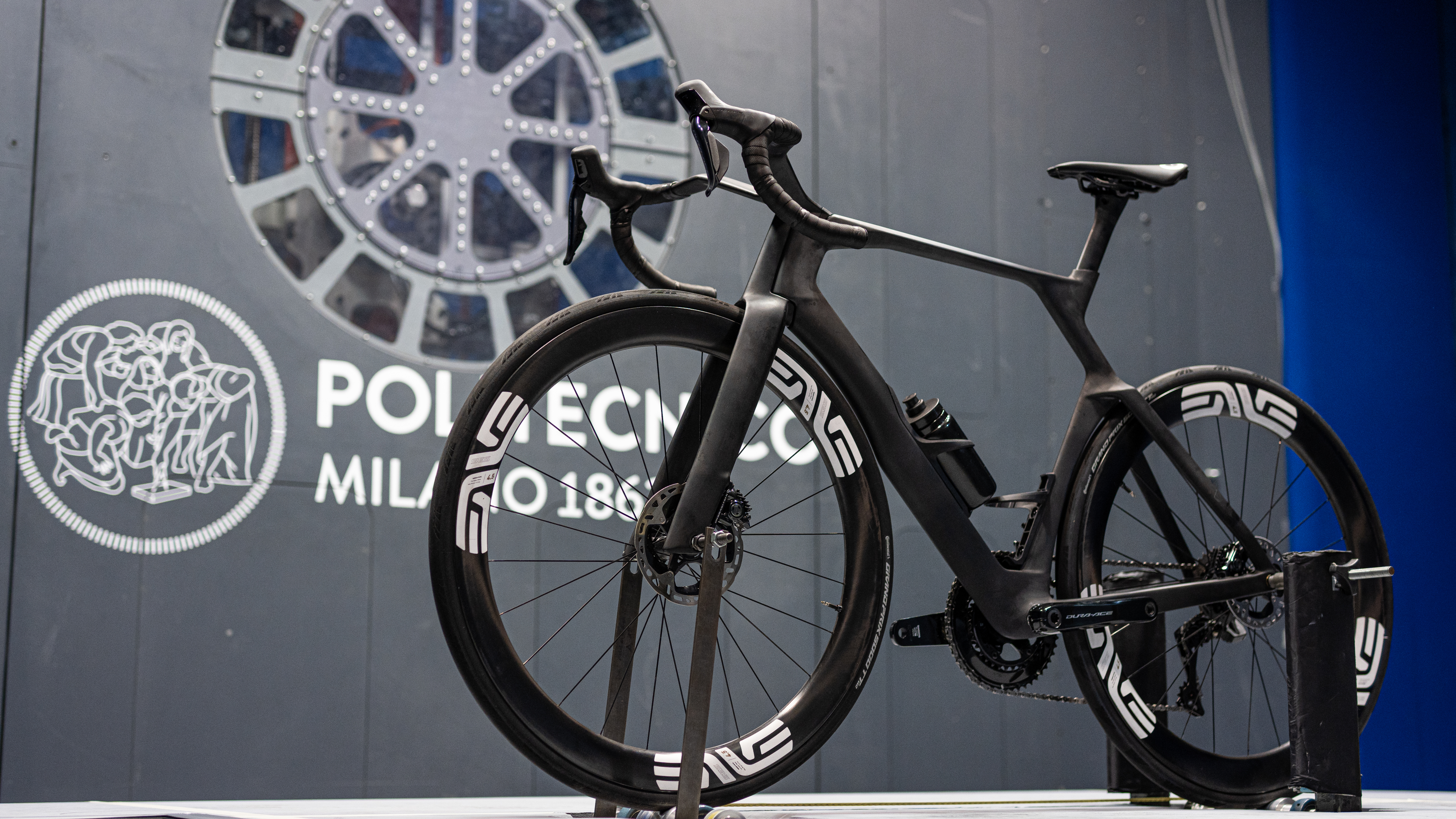The Tour de France just killed the climbing bike - here’s the physics that proves it
A lightweight bike must be easier to ride on a hilly course? The science says no, and this is why the climbing bike might be dead in WorldTour racing, but it doesn't mean they're of no use to you and I.

Andy Carr

The 2025 Tour de France saw 3320km of racing and 51500m of climbing.
The overall winner, Tadej Pogačar of Team UAE Emirates-XRG and Jonas Vingegaard of Visma-lease a Bike, have at their disposal two dedicated aero bikes and two lighter climbing frames. Pogačar has access to the aero Colnago Y1RS, and the lighter weight, less aero, V5RS. Vingegaard has the aero Cervelo S5 and the lightweight Cervelo R5.
Despite many other teams also using a two-bike strategy, informed by the conventional wisdom that the aero bike is for flatter stages, and the climbing bike is essential when the parcours points skyward, the top two riders didn’t touch their climbing bike. For the entire event.
This must have been tough to watch for the brands involved. Both Cervelo and Colnago delivered significant updates to both platforms for this season, giving their respective teams access to heavily overhauled new, objectively better new climbing packages.
The V5RS we reviewed recently is one of the best road bikes of its type, and whilst the old R5 was getting a little bit long in the tooth, the new version saves even more weight, in what any casual observer would assume should have been the perfect weapon for Tour success in the mountains.
So why then did both the V5RS and R5 stay in the truck for the whole race, and critically, does this mean the climbing bike is dead?
The new Cervelo R5 claims to be right on or under the 6.8kg legal limit in every frame size, and the Colnago was designed to be lighter and more aero than the already svelte V4RS it replaced. So why, even on stages with over 4000m of elevation gain and HC summit finishes, did neither rider use these brand new lightweight options once?
The latest race content, interviews, features, reviews and expert buying guides, direct to your inbox!
To explore why, we need to turn to physics.
Lightweight bikes are founded on two solid scientific principles. The first equation we can turn to for an explanation is ‘P = m * g * v * sin(θ’). This is the principle that Power (P) required to climb is equal to total mass (m) times acceleration due to gravity (9.81 m/s²), times velocity in m/s, times sin of the angle of the climb.
For those of you who need that in English, that means that a steeper gradient, or higher system weight, requires more power to move at a constant velocity or speed.
But that’s not the whole picture yet, so bear with me whilst we also turn to Newton’s Second Law of Acceleration. Here, ‘F = ma’. That means that when mass is increased (the bike or system weight gets heavier), then more force is required to match the same acceleration.
That’s still not the whole story. We need to take into account the gradient too. Working against your progress as you push the pedals and lift your bike, you’re also subject to the forces of gravity. We can add that in, of course, and it looks like this: ‘F gravity = m * g * sin(θ)’, where g is the acceleration due to gravity (9.81 m/s²), and θ is the incline angle.
In simple terms, this calculation shows that the steeper the angle, the greater the impact.
What none of these formulas, elegant though they are, take into account is air resistance. Air resistance is one of the most significant forces that cyclists have to overcome when cycling.
In the Tour de France, where the average race speed this year was a reported 42.85kph, that means aero is all very important indeed. But surely, for us mere mortals, who can only dream of those speeds most of the time, that’s completely irrelevant?
Wrong, sadly. Even at 25kph, using a 75kg system weight, gradient of 7%, typical rolling resistance (Crr) of 0.004, a coefficient of drag of 0.32m2, at sea level air density, the percentage of force that goes to overcoming aerodynamic drag is still significant, at around 14.8%.
What if we go faster? And ride at speeds of 30kph. Remember, 30kph is the speed at which grand tour cyclists will race uphill at, but the percentage of force that goes into overcoming aerodynamic drag at that speed now jumps up to 20%. Accelerations themselves result in ever greater air resistance, all of which has to be overcome.
In straightforward terms, at 30kph, the rider in this case is using a whopping fifth of their effort just to push through the air, regardless of incline.
There is then another factor. What goes up must come down. For every mountain that needs to be ridden up, save for summit finishes, there is a descent. The Mont Ventoux stage also had around 130km of flat roads. In that case, despite the gargantuan climb, at the average race speed of 42.85kph, air resistance for that stage becomes 90.4% of the total forces that a rider needs to overcome. Read that again. 90.4% of the total effort invested by the rider is spent on pushing through the air.
At 70kph downhill, where gravity comes to assist, not hinder, drag accounts for even more at 96.2%. As we’ve learned, this is because the drag force increases at the square of the velocity, whilst power to overcome this drag increases at a cubic rate relative to velocity. As speed increases, air resistance increases massively. The faster you go, the harder it is to push through the air.
That means, when you break it down into what is the fastest solution, even on the hilliest of stages, an aero road bike is still faster than a lightweight climbing bike.
There are a few caveats to this, though. Firstly, the UCI weight limit of 6.8kg is at play in the WorldTour. Many aero bikes can now be built down to 6.8-7.2kg in the frame sizes that GC riders use. It’s that increasingly narrow difference that’s rendering many climbing bikes obsolete.
It used to be the case that aero bikes were significantly heavier, or suffered from poor ride quality, such was the amount of material needed to make them slippery. But, Pogačar’s paint-stripped Y1RS was just a slip heavier than his V5RS, and extremely close to the UCI weight limit. Meanwhile, a lightweight climbing bike that could in theory, be built down to something flyweight like 5.8kg just isn’t possible, as weight has to be added to meet the UCI’s weight limit.
You and I aren’t constrained by the UCI of course. So your lightweight bike must be faster than the heavier aero equivalent? Not so. Whilst you can ride around on a 5.9kg bike these days, without even going full weight-weenie thanks to modern frame design, it’s not the panacea you might have assumed it is.
Of course, lightweight is associated with a certain perception of speed. Lightweight ‘feels’ faster when changing pace up a climb. But the harsh reality is that aero is still actually quicker, and perceptions are just that. We can’t neglect the placebo effect, but that’s often all it is.
Should we stop buying climbing bikes?
So does this mean the climbing bike is actually dead, regardless of if you’re in the WorldTour or not? The truth is, if anyone reasonably handy on a bike wants to increase the speed of their cycling, even if they live in a hilly area, then an aero frame will be the faster option, even if it’s heavier. Even if you want to go up climbs as fast as possible, aero will, in most scenarios, be faster.
And here’s the kicker. There is a trade-off point where reducing weight can make a bike faster than an aero frame, provided the drag (CdA) doesn’t increase beyond where the weight saving is more beneficial. However, this varies based on gradient and speed. A 9kg aero bike might not be best suited for something like the Maratona Dolomites compared to a 6kg climbing machine.
There is also that element that a lightweight bike can feel more fun, which is undoubtedly my perception when riding. The most fun bike I own to ride has 40cm bars, exposed cables, and Dura Ace mechanical, and I love it. The fastest bike I have to ride has 32cm bars and aero bits and pieces, but it does not feel as nimble to ride. It is, however, categorically faster.
Even for those riding at slower speeds and not constrained by the UCI weight limit, a good level aero bike that is within 1kg of the lightweight alternative is likely to be the faster option throughout a longer, even hillier route. For those racing, aerodynamics wins out every time.
But for those who just want to ride their bikes and feel sensations of speed and brisk accelerations, a lightweight bike may be the more fun option. If you want to go faster, consider a bike that allows you to optimise your riding position for better aero, as the body makes up around 80% of the total drag in the system, and the bike is just a small part of that anyway.
Aero bikes are also often more uncomfortable than their more traditional looking lightweight cousins. Comfort isn't often discussed as a performance parameter sadly, but if you want to go a long way, fast, some comfort makes a lot of sense.
As aerodynamicists, there are ways we know we can make our climbing bikes faster. For example, a deeper front wheel will be worth more aero savings for the same weight than a deeper rear wheel. The new Specialized Roval Sprint wheels are certainly on to something there. Additionally, for minimal resistance and weight saving, a skinsuit will often be lighter than a shorts and jersey combo, while also being more aerodynamic.
When it comes to bikes however, if fit and geometry are the same, aero will be faster almost everywhere and in nearly every scenario.

Cervelo's new R5 tips the scales at on or under the UCI weight limit regardless of size, so why did the more aero S5 get all the limelight at this year's Tour de France?
Andy is a Sport & Exercise Scientist, fully qualified and experienced Cycling Coach, Sports Director, Freelance Writer, and Performance Consultant. He spent 3 years riding for a UCI cycling team and 7 years as a BC Elite rider, competing in prestigious events such as the Tour of Britain and the Volta a Portugal.
Graduating with a first-class honours degree in Sport & Exercise Sciences, he continues to pursue his interest in research in the field of Sport Science alongside managing his coaching business, ATP Performance. He also works as a Wind Tunnel operator and Performance Consultant at the Silverstone Sports Engineering Hub, working with individuals, teams, and businesses to optimise performance and develop products.
- Andy CarrCycling Weekly Tech Editor
You must confirm your public display name before commenting
Please logout and then login again, you will then be prompted to enter your display name.
